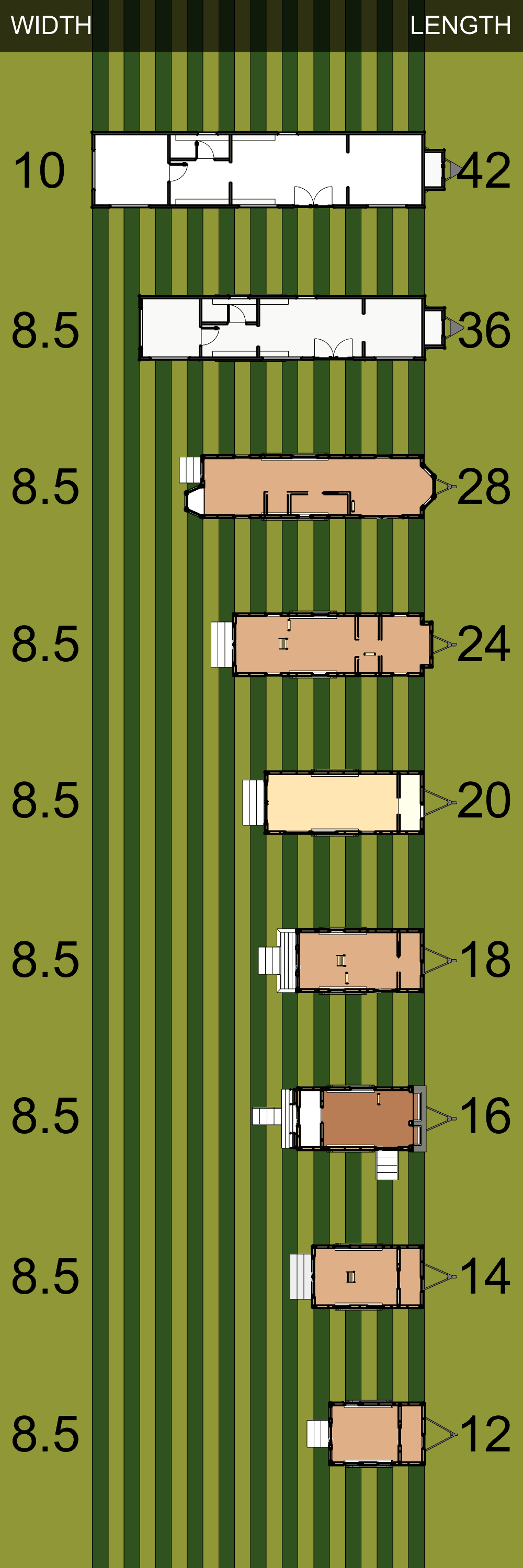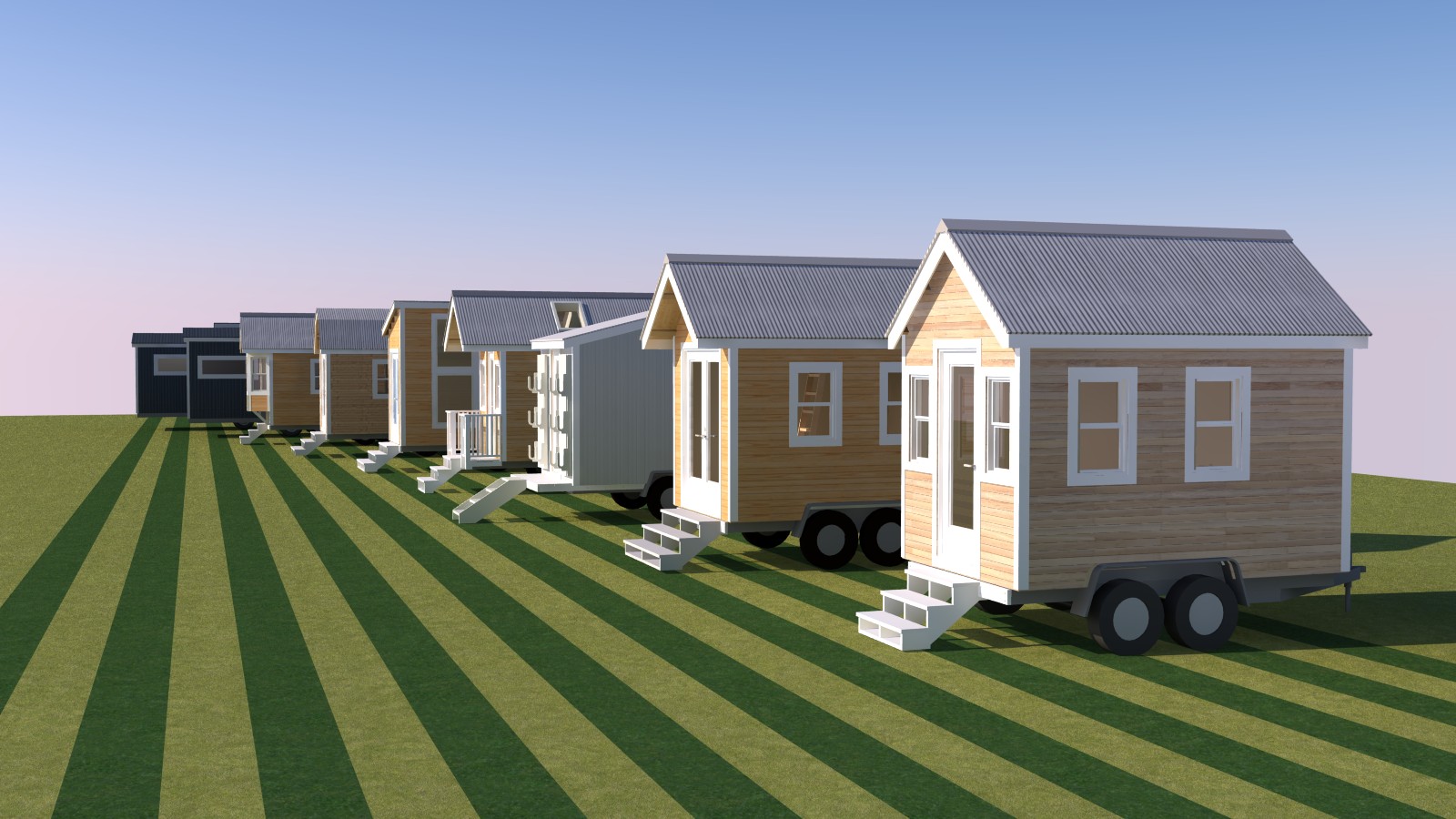I thought I’d show you just how big tiny houses are becoming. I’m also curious to know what you think about this trend – so if you have a strong opinion leave it in a comment below.
In the beginning, tiny houses were very small. Jay Shafer’s original Tumbleweed was 12-feet long, which is the length of the first house in the image above.
Since then tiny homes have been getting bigger to accommodate more people and functions… and honestly, more comfort. As the size has increased, cost & weight have increased while portability has decreased.
Some wonder if the Tiny House Movement has lost its way. Others argue that homeowners of larger tiny homes are still being rewarded by the benefits of downsizing.
To demonstrate the change in size visually I’ve created this comparison of the houses I’ve designed over the years. This is just a small sample showing the range of sizes.

Is this trend good for the tiny house movement? Is slightly bigger better? What do you think? Leave your thoughts below.


Since it is a home and not a house, each has its advantages; some prefer bigger to be more comfortable and for the many who are living in it. Yes, the cost increases, but better to be a bit bigger and comfortable with all needs than smaller, cheaper, but not happy.
The size depends on how many are going to be living there. I live in a 32 foot fifth wheel and I love it. I would have liked to live in a tiny house but could not afford it at the time. I bought my home used.
I think having a “big” tiny house still makes more sense than a conventional stick-built house environmentally, but as houses become bigger they become more costly, which may make the financial reasons for building a tiny house less clear. I’d personally like to see plans for tiny houses that could be put on land and added onto in a controlled, planned way.
I’ve noticed this trend for a while now. Now, all of a sudden, the makers of storage buildings have become tiny house builders. They’re not cute like the original tiny homes and I wonder structurally sound they are.
I can understand families needing and wanting more space, but as a single woman all I need is the bare essentials and a place to create my art.
While I understand the need for a bigger THOW it feels as if it negates the purpose of the movement and it drives prices up the fancier they get. It is the way of things but I feel a little upset and miss the beginning of the movement and its more minimalist ideals. Still, a bigger THOW is still smaller and greener than a standard foundation type house. In my opinion a 24 foot is a sweet spot but probably too small for some.I think more than the size it is this trend towards more plastic looking insides that I dislike.
I’m definitely finding the trend toward THOW with stairs appealing, but it seems like all of these are like 300sf…I know there’s a way that you can make a loft and stairs with a tinier house. Maybe not 100sf, but certainly less than 200. Tiny washer or washer/dryer combo, wet bath, small kitchen, space to sit and sleep and lots of storage for things you want to keep but don’t use every day. Like books, especially… And why does every house need a queen or king size bed? For one person, a twin or full should be plenty. Yeah, tiny homes were really cool when they first started appearing, and people started expanding on ideas…but I don’t know if a 500sf tiny home really qualifies as a “tiny home” anymore…smaller than normal, sure, but my HOUSE that I live in is 963sf. 3 bedrooms. 1 bath. Very small house and yet we have LOTS of room for all of our junk that we don’t need.
Tiny houses are dead! Now its all about mini mansions. No more using recycled rv trailers and being creative. Now they tend to be over-priced, oversized manufactured Rvs. The original concept of JS has been lost.
I don’t think it’s dead, they are still out there and are being built by folks. They just don’t get put on TV.
Though the original tiny house movement has always fascinated me—I deeply admire the creativity born of frugality and good stewardship toward our planet—it’s simply never been a viable option for our family. I wouldn’t cram five people into a 200 sq ft THOW just to be “true to the movement,” so the option is either a traditional suburban house or a larger “tiny house.” While it might not adhere to the strictures of the original movement, isn’t it, at least, an improvement over the McMansion uprise in suburbia? If more people, even those in the McMansions, were influenced by the THOW movement and began implementing changes in the way they power their homes, isn’t that a win, too?
I suppose the answer lies in what one views as the underlying purpose of the TH movement.
My daughter is about to move into her version of a “tiny house”—a used 405 sqft trailer on her own land. She eventually plans to build a custom tiny house. As retirement looms, my partner and I are looking at doing something similar, though with more square footage to welcome visiting grandchildren and friends. That may not be important to some, but it’s a priority for us. We’ll need a creative floorplan to accommodate this and keep the square footage low, so a larger “tiny house” would be ideal. Perhaps not a THOW, but a structure heavily influenced by the movement. So, you can see which side of the argument I fall on. 😉
Side Note: Though I’ve been a subscriber for a while, I’ve never commented, so I wanted to take this opportunity to thank you, Michael, for the informative and interesting blog posts. I enjoy them all.
Rider, I completely agree with having room for the grandkids. My husband and I are finishing our 16×32 foot small home with a 16×8 front porch. We were able to get cathedral type ceilings which allowed for a rather large loft over our 16×12 main bedroom and our 7×8 bathroom. We finished it up there but have not put any beds or ladders yet. We are getting a daybed as one of the seating areas and it has a trundle. I did not want to live in 8 ft wide but did want a smaller house for my retirement. Less to clean but still wheelchair accessible if needed later.
My original floor plan came from Excellentfloorplans.com Put in your size and see plans for that size. $40 or less for most plans that if stick built, county inspectors will approve.
I’ll have to check that site out. Thanks, Loretta!
I originally thought the tiny house was cute but totally impractical to actually live in. But now that they have become a bit larger I can actually see myself living in one something I could never imagine with Jay Shafer’s houses. I always thought single wide mobile homes were cute and practical but shoddy. The larger tiny does the same thing but with quality and sturdiness the mobiles never had.
Tiny houses fascinate me like people who live full time #vanlife . There are basic living spaces to huge, elaborate conversions of Sprinter vans etc. It’s not just minimizing your life, I think the original fascination was that, how much of a ‘regular’ life could you cram into a much smaller space, and then, be able to move it around? Your literal home away from (permanent/stationery) home.
The whole thing got people thinking. It’s like, they never considered it and tiny homes opened their eyes. I especially love the way some cities have used a most basic form of a tiny house to help with homelessness, people needing help who are in recovery or people needing a place to be while job hunting.
I don’t think the movement has lost its way, it’s just evolved, as ideas do. Just find what you need/want, and work towards it! Go back to Jay’s basic, or go all out. In the end, you are the one cleaning it, paying for it, moving it (or not), and everything else that goes along with it.
Each tiny house has a purpose for someone.
The little THOWs are great for those who are extremely minimalist or maybe want to travel with their tiny house.
The medium to large THOWs are great for staying put somewhere and living on very little or to have in the backyard.
Beyond that, THOWs are just one option. Then there are vans, school bus conversions, and just about anything you can think of.
But to me, the REAL movement is when we start seeing communities and developments that are catering to us.
When we start seeing zoning laws change to allow for tiny and small homes.
When we start to see small (not just tiny) homes being legalized again.
Remember, in most populated areas, you can’t even build a new house that’s less than 1200 sq. ft. So it’s not really just about TINY.
It’s about LEGALIZING SMALL HOMES too.
IMO, the popularity of tiny houses on wheels is only because of how difficult it is to build a small affordable house today. It’s pretty much illegal!
Think about it, until before this movement, you couldn’t find small homes under 1000 sq. ft. anywhere unless they were grandfathered in or some sort of guest house/accessory dwelling unit. And for the most part, it’s STILL like this everywhere today.
Okay, my rant is over now.
I have been day dreaming of owning my own tiny house for the past 8 years. However, I would like to build one on a permanent foundation…preferably on piers. But, as Alex points out, it is nearly impossible to find property that would allow such a build. Unless you are willing or fortunate enough to buy lots of acreage and build off-grid. I’m older and just need a small piece of a lot. I think there are a lot of people that would like to shrink their footprint like myself if only ordinances in most cities/towns would allow it. As far as the “movement” goes…I agree that it is evolving. It’s not a fad like bell bottoms, or hip huggers (I’m giving away my age!) I believe tiny/smaller homes are needed and wanted and are here to stay. We just need to figure out how to convince local governments.